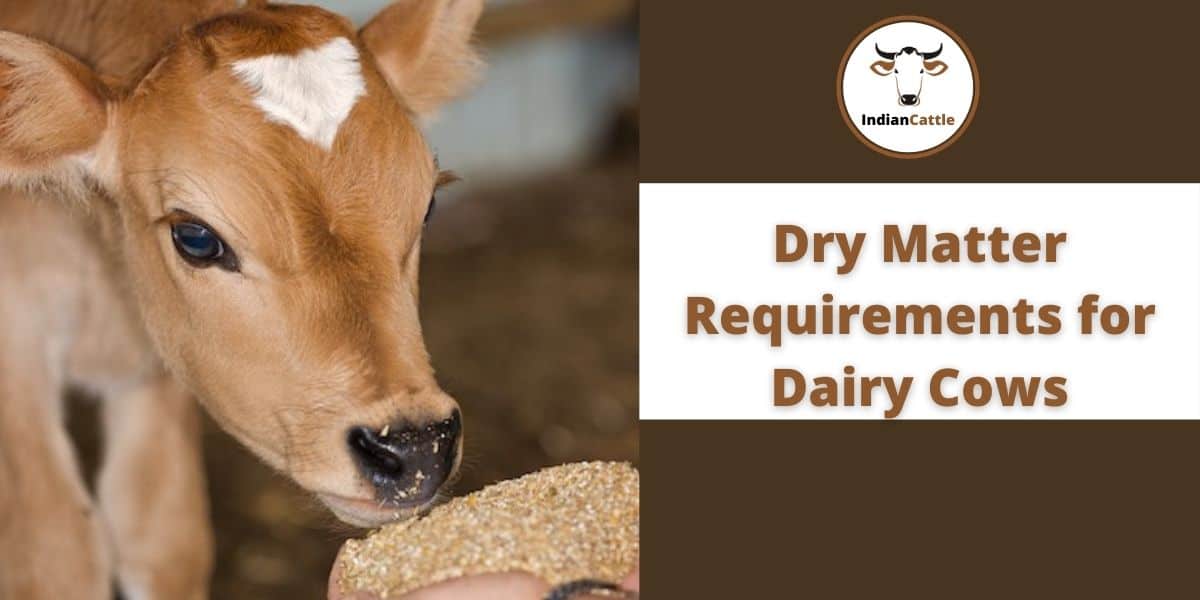
Dry Matter Requirements for Dairy Cows
Dry Matter Requirements for Cattle
Almost all feed and fodder contain water in varying amounts. Dry matter is the portion of feed/fodder remaining after all the water has been taken out. The dry matter in the feed will represent nutrients, energy, protein, fat, fibre, vitamins and minerals. Dry matter in the laboratory is measured after drying a sample of the feed-in hot air oven. This blog explained the information on dry matter requirements for cattle, dry matter content for feed and how to calculate dry matter. This is expressed as %, which is calculated from the formula:
| DM % = Weight after drying x 100 / weight before drying |
Dry Matter Content of common feed/fodder:
| Dry Matter | Moisture | Feed |
| 10 | 90 | Short leafy grass |
| 30 | 70 | Silage |
| 40 | 60 | Long Stemmy grass |
| 50 | 50 | Baled silage |
| 80 | 20 | Hay (dried grass) |
| 90 | 10 | Straw (wheat, rice) |
How to Calculate Dry Matter Requirements for Cattle?
Complex stomach cows will consume dry matter (DM) 1-3% of their body weight, but this will depend on a number of factors. What is important is that cows should be satiated (means contended and not feel hungry) and its’ energy requirements are met from the DM consumed.
Thumb Rules
There is a number of thumb rules but it is better than a farmer based on observing feeding behaviour and type of feeding will decide the DM intake. As a general rule, a cow will feed satiated if she is can receive its energy requirements for the day in 2-2.5% of its body weight. When cows are fed less-digestible, low-energy, high-fibre diets (such as straw) the DM intake will be low as such feed/fodder require longer rumen stay to digest hence emptying will be delayed. Such cows will not be able to meet energy requirements but will appear full and would not feel hungry. Whereas, consumption of highly digestible, high-energy, low-fibre feeds (such as grains) are fed these digests faster hence passage through rumen is faster and although its energy requirements have been met she will feel hungry.
Thus, voluntary intake of high energy low fibre feed is much higher and for low-quality straws, voluntary intake is low (maybe 1-2%), whereas when greens are fed the DM intake may go up to 2-3% of the body weight. Farmers, therefore, must ensure both satiety (that is rumen fill) as well as energy requirements).
Factors Deciding Dry Matter Intake in Cattle
The DM intake is also dependent on the number of cows in the herd (density) and bunk space available (less competition), body condition, stage and level of milk production, comfort level and environment temperature. DM intake is also dependent on supplements fed. Protein supplements (rumen degradable) have been found to improve DM intake as nitrogen released from protein digestion will expand rumen microbiome. It has been observed that cows fed on alfalfa (lucern grass) will be able to digest feed faster hence would demand feed frequently. The factors that influence the amount a cow will eat include her size, body condition, stage and level of production. Other factors include the quality and availability of forage, amount and type of supplements and her environment. Cows in housed in loose housing will have higher DM intake of even low-quality roughages compared to when these are in the tied barn. Feeding more dry matter than is required to meet an animal’s needs is a waste of feed. For example, when high-quality alfalfa hay is fed, the energy and protein requirements can be met with about 8 kg of hay. Since the rate of passage will be relatively fast, the cow may appear hungry before the next feeding, even though her nutrient requirements have been met With straw the maximum voluntary dry matter intake has been found to be 9 kg and would meet hardly 50% of the energy requirements, although the cow may appear full.
Highly palatable feeds encourage consumption, while bitter-tasting feeds, no matter the value, will limit consumption. When molasses is mixed in feed (such as pellets) dry matter consumption is increased. Molasses-based supplements encourage dry matter consumption and would also increase rate of passage. In addition, decreases in dry matter intake have been observed with advancing pregnancy, although at this stage nutrient requirement due to growing foetus is higher. In this stage feeding, high energy density feed is an option. Whereas in middle trimester pregnancy, cows may be fed low-quality roughage to meet both dry matter and nutrient requirements.
Read More: How do we Keep Dairy Cattle Cool in the Summer
